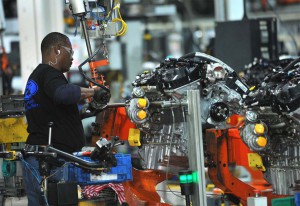
The new job cuts won't directly impact Ford's hourly workers - but they have been facing a series of temporary plant closures in recent months.
Ford Motor Co. has revealed plans to cut about 1,400 salaried jobs in North America and Asia as part of a cost-cutting plan, but the move is significantly smaller than had been suggested by some news reports earlier in the week.
The move comes as Ford struggles to boost sales and earnings after a sharp slump in recent months. The second-largest automaker has also been trying to boost its stock price, which has tumbled about 40% since Mark Fields became CEO nearly three years ago. But the initial response by investors is proving lackluster.
“We remain focused on the three strategic priorities that will create value and drive profitable growth, which include fortifying the profit pillars in our core business, transforming traditionally underperforming areas of our core business and investing aggressively, but prudently, in emerging opportunities,” Ford said in a statement early Wednesday, updating comments the maker had released earlier in the week.
“Reducing costs and becoming as lean and efficient as possible also remain part of that work, including plans to reduce 10 percent of our salaried costs and personnel levels in North America and Asia Pacific this year, using voluntary packages,” the company confirmed.
Some early reports had suggested Ford might cut as much as 10% of its total global workforce of around 220,000 employees, others more accurately noting the cutbacks would target only salaried employees.
(GM announces temporary layoffs in bid to reduce bulging inventories. Click Here for that breaking story.)
In fact, there are a number of caveats concerning which groups of white-collar workers will be offered buy-outs next month:
- About two-thirds of the job reduction will occur in North America. Though Ford has not broken down the numbers by country, the U.S. is expected to feel the brunt of the workforce reduction;
- The remaining cuts will focus on Ford’s Asian operations. Europe and South America, after already undergoing belt-tightening, will not be affected;
- The automaker says the headcount reduction will not affect its product development and Ford Credit financial operations.
Late last month, Ford told analysts and investors it would trim about $3 billion in costs. That news followed the release of the company’s first-quarter earnings which tumbled 35%, to $1.6 billion, year-over-year.
(Click Here for more on Ford’s weak Q1 financials.)
Ford has also been watching its U.S. sales slide in recent months, a downturn even steeper than the overall decline of the American market after three years of record demand. Analysts say Ford has failed to respond effectively to dramatic shifts, notably the boom in light truck sales; utility vehicles and pickups now account for nearly two-thirds of the American new vehicle market.
Ford is adding new capacity, among other things converting a suburban Detroit plant to build a new SUV reviving the old Bronco nameplate, as well as a new midsize pickup that brings back the Ranger badge.

Ford hopes to exploit strong SUV demand with new models like the reborn Bronco, a concept shown here.
To make room for those vehicles, Ford is transferring production of several slow-selling passenger car models, including the Focus, to Mexico. But that move set off a political firestorm during the presidential campaign last year, then-candidate Donald Trump launching a Twitter attack on Ford and threatening retaliatory measures, including a border tax.
Trump, in January, tried to take credit when Ford announced it was canceling a second Mexican plant. In reality, the maker said it changed plans due to declining passenger car demand. And it said the Focus was still moving to Mexico, but production would be consolidated into an existing factory there.
The latest announcement from Ford could prove another setback for Trump’s push to create more jobs in American manufacturing. The good news – for now – is that it won’t impact hourly employees. But Ford has been rolling out a series of temporary plant closings and layoffs since the U.S. automotive market began to slow last year. And industry analysts like Joe Phillippi, of AutoTrends Consulting, say that pattern could accelerate in the months ahead if sales don’t rebound.
Ford has not said how the new job cuts will impact its earnings for all of 2017. It previously forecast re-tax earnings of $9 billion, down from $10.4 billion for all of last year.
Investors reacted coolly when word of the job cuts first leaked out earlier this week. And the response wasn’t much better as the market opened on Tuesday to what is a smaller reduction in force than some had anticipated. As of 10 AM, Ford shares were off by more than 1%, to around $10.83, continuing a nearly two-week slide.
(Weak share price slammed by Ford investors at annual meeting. Click Here for the story.)

